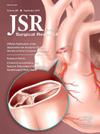阿片类药物在外科重症监护病房复杂通气患者中的应用。
IF 1.7
3区 医学
Q2 SURGERY
引用次数: 0
摘要
在外科重症监护室(SICU)进行有效的疼痛管理是具有挑战性的,特别是对于需要神经肌肉阻断剂(NMB)输注或体外膜氧合(ECMO)支持的通气患者。虽然阿片类药物是有效的,但它们会带来镇静、呼吸抑制和戒断等风险。关于NMB和ECMO如何影响SICU通气患者阿片类药物使用模式的数据仍然有限。我们假设NMB和ECMO与阿片类药物使用增加有关。材料和方法:本回顾性观察性研究在单一学术医学中心进行。数据从电子健康记录中提取,并使用商业智能工具进行可视化。根据患者的ECMO状态进行分组,然后根据ECMO和NMB的组合进一步分为四组。统计分析包括卡方检验、t检验、Wilcoxon秩和检验和多变量线性回归模型。结果:共纳入1550例患者,其中ecmo支持患者23例,非ecmo患者1527例。在ECMO患者中,NMB与阿片类药物使用增加265.1%相关(774.89比212.24 MME/患者/d, P = 0.007),而非ECMO患者NMB与阿片类药物使用增加226.5%相关(558.23比170.97 MME/患者/d, P < 0.001)。在NMB患者中,ECMO和非ECMO患者的阿片类药物使用相似(P = 0.112)。在非nmb患者中,ECMO和非ECMO患者的阿片类药物使用也相似(P = 0.725)。结论:NMB输注与这些患者阿片类药物使用增加相关,而单独ECMO与阿片类药物使用无显著相关性。这些发现强调了在这一复杂人群中减少过量阿片类药物使用的策略的必要性。本文章由计算机程序翻译,如有差异,请以英文原文为准。
Opioid Administration in Complex Ventilated Patients in a Surgical Intensive Care Unit
Introduction
Effective pain management in the surgical intensive care unit (SICU) is challenging, particularly for ventilated patients requiring neuromuscular blockade (NMB) infusions or extracorporeal membrane oxygenation (ECMO) support. While opioids are effective, they pose risks like sedation, respiratory depression, and withdrawal. Data on how NMB and ECMO influence opioid utilization patterns in ventilated SICU patients remain limited. We hypothesized that NMB and ECMO are associated with increased opioid utilization.
Materials and methods
This retrospective observational study was conducted at a single academic medical center. Data were extracted from the electronic health record and visualized using a business intelligence tool. Patients were grouped by ECMO status and then further stratified into four groups based on the combinations of ECMO and NMB. Statistical analyses included chi-square tests, t-tests, Wilcoxon rank-sum tests, and multivariable linear regression models.
Results
A total of 1550 patients were included in the study, including 23 ECMO-supported patients and 1527 non-ECMO patients. Within ECMO patients, NMB was associated with 265.1% higher opioid use (774.89 versus 212.24 MME/patient/d, P = 0.007), while non-ECMO patients with NMB had 226.5% higher opioid use (558.23 versus 170.97 MME/patient/d, P < 0.001). Among NMB patients, opioid use was similar between ECMO and non-ECMO patients (P = 0.112). Among non-NMB patients, opioid use was also similar between ECMO and non-ECMO patients (P = 0.725).
Conclusions
NMB infusions were associated with increased opioid utilization in these patients, whereas ECMO alone was not significantly associated with opioid use. These findings underscore the need for strategies to reduce excessive opioid use in this complex population.
求助全文
通过发布文献求助,成功后即可免费获取论文全文。
去求助
来源期刊
CiteScore
3.90
自引率
4.50%
发文量
627
审稿时长
138 days
期刊介绍:
The Journal of Surgical Research: Clinical and Laboratory Investigation publishes original articles concerned with clinical and laboratory investigations relevant to surgical practice and teaching. The journal emphasizes reports of clinical investigations or fundamental research bearing directly on surgical management that will be of general interest to a broad range of surgeons and surgical researchers. The articles presented need not have been the products of surgeons or of surgical laboratories.
The Journal of Surgical Research also features review articles and special articles relating to educational, research, or social issues of interest to the academic surgical community.

 求助内容:
求助内容: 应助结果提醒方式:
应助结果提醒方式:


